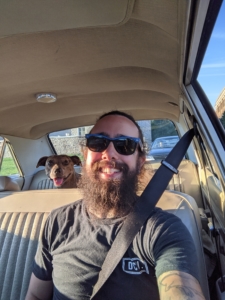AMI-Quebec’s Education and Outreach Program: Interview with Tony Alfonso, Outreach Coordinator
 What is the Education and Outreach program?
What is the Education and Outreach program?
We do presentations and hold discussions in person and online. Our programs bring awareness to the stigma around mental illness. We want to talk about mental illnesses and dispel the myths around them and try to show how people can support each other, whether it be caregivers, those living with a mental illness, family members, employers, anybody really.
What is your role?
I coordinate all the presentations that we give. I also try to come up with new presentation ideas and different outreach program initiatives. We focus on the presentations and interactive content: for example, we have live videos on Facebook about what we call “Hot Topics” once a month. We talk about a specific issue, like mental health in the workplace, and we have a health or other professional and a host that engage in a discussion where we can explore the questions of the public. It’s not a debate, more of a conversation. We have pamphlets with information on different mental illnesses as well.
How does it work? What about the COVID-19 situation?
We reach out to organizations, or they reach out to us, to give a presentation. Right now, with the current COVID-19 situation, we are doing all of our presentations through Google Meet. Our “Hot Topics” segments are done on Facebook Live.
Who is the program for? Is it just schools?
It’s definitely not just for schools! We don’t have one specific group we target for our presentations. We speak to students, community organizations, medical professionals, businesses, corporations, caregivers and people suffering from mental illness. There are no limitations on who we try to reach.
What does a typical presentation look like?
In a typical presentation, a volunteer, who has lived experience as a caregiver or having a mental illness or both, talks about various mental illnesses and the stigma and discrimination associated with it. There is some educational content, but also practical content because they tell their own story and try to give context for what living with all of this looks like in the real world. At the end of the presentation there is a question period where the audience can ask about the general subject presented or ask something specific to the presenter themselves. In the future, I personally want to do follow-ups with these different organizations for more discussions to take place after the audience has digested the information they were presented with and to allow for more back and forth dialogue instead of just the presenter speaking.
Why is it important to have these types of programs?
I think the biggest problem around mental illness is the stigma associated with it, and I think the Education and Outreach Program allows people to have open and honest discussions around mental illness as a caregiver, someone with a lived experience of mental illness, or simply just information to better understand where people are coming from and where they are at. This allows for a discussion; even little talks about language, for example, can make a big difference. Education and talking about it is the best way to address stigma, because if we don’t talk about it, it will remain this great unknown. Is there a particular presentation that had a big impact on you? Every single one of our volunteers has such an amazing story that I can’t pick out one. They all impress me with their resilience and commitment to helping others through their own actions.
– Gabrielle Lesage
Click here for more information or to request a presentation.


